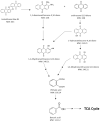Enhanced degradation of anthraquinone dyes by microbial monoculture and developed consortium through the production of specific enzymes
- PMID: 33828207
- PMCID: PMC8027401
- DOI: 10.1038/s41598-021-87227-6
Enhanced degradation of anthraquinone dyes by microbial monoculture and developed consortium through the production of specific enzymes
Abstract
The current study investigates the decolorization of Indanthrene Blue RS dye and the optimization of process parameters needed for effective decolorization by the bacterial consortium. The pure culture of strain TS8, PMS, and NCH has been isolated from the textile wastewater sample collected from local textile processing units outlet and dye contaminated soil from Odisha, India. A bacterial consortium-BP of Bacillus flexus TS8 (BF), Proteus mirabilis PMS (PM), and Pseudomonas aeruginosa NCH (PA) were developed. The physicochemical parameters were optimized to attain maximum decolorization efficacy. Degradation of Indanthrene Blue RS and the formation of metabolites were confirmed through UV-vis spectroscopy, FT-IR, and GC-MS analysis. The developed consortium-BP showed an enhanced decolorization of Indanthrene Blue RS dye with an Average decolorization rate of 11,088 µg h-1 within 9 h compared to the individual strains under aerobic conditions. The supplementation of agricultural residual wastes showed increased decolorization efficiency of consortium-BP. Higher reduction in TOC and COD removal (≥ 80%) determined the mineralization of Indanthrene Blue RS by consortium-BP. Significant induction of various oxidoreductive enzymes in consortium-BP compared to that of Individual strains indicates their involvement in the overall decolorization and degradation process, with the higher protein concentration in the intracellular enzymes. Studies on the phytotoxicity effect revealed the non-toxic nature of the degraded products formed on mineralization of Indanthrene Blue RS by consortium-BP. This study represents a new approach for enhanced biodegradation using consortium-BP in treating textile wastewaters containing anthraquinone dyes.
Conflict of interest statement
The authors declare no competing interests.
Figures




Similar articles
-
Response surface methodology mediated optimization of Indanthrene Blue RS by a novel isolated bacterial strain Bacillus flexus TS8.Water Environ Res. 2020 Apr;92(4):569-578. doi: 10.1002/wer.1246. Epub 2019 Oct 11. Water Environ Res. 2020. PMID: 31556198
-
Decolorization and biodegradation of reactive dyes and dye wastewater by a developed bacterial consortium.Biodegradation. 2010 Nov;21(6):999-1015. doi: 10.1007/s10532-010-9360-1. Epub 2010 Apr 21. Biodegradation. 2010. PMID: 20407917
-
Enhanced decolorization and biodegradation of textile azo dye Scarlet R by using developed microbial consortium-GR.Bioresour Technol. 2009 May;100(9):2493-500. doi: 10.1016/j.biortech.2008.12.013. Epub 2009 Jan 20. Bioresour Technol. 2009. PMID: 19157864
-
Exploring potential bacterial populations for enhanced anthraquinone dyes biodegradation: a critical review.Biotechnol Lett. 2022 Sep;44(9):1011-1025. doi: 10.1007/s10529-022-03279-2. Epub 2022 Jul 24. Biotechnol Lett. 2022. PMID: 35871405 Review.
-
Phytoremediation of textile dyes and effluents: Current scenario and future prospects.Biotechnol Adv. 2015 Dec;33(8):1697-714. doi: 10.1016/j.biotechadv.2015.09.003. Epub 2015 Sep 18. Biotechnol Adv. 2015. PMID: 26386310 Review.
Cited by
-
Sustainable biodegradation of malachite green dye by novel non-pathogenic Pseudomonas aeruginosa ED24.World J Microbiol Biotechnol. 2025 Jan 22;41(2):44. doi: 10.1007/s11274-025-04251-8. World J Microbiol Biotechnol. 2025. PMID: 39841300
-
The invisible architects: microbial communities and their transformative role in soil health and global climate changes.Environ Microbiome. 2025 Mar 25;20(1):36. doi: 10.1186/s40793-025-00694-6. Environ Microbiome. 2025. PMID: 40133952 Free PMC article. Review.
-
The degradation of textile industry dyes using the effective bacterial consortium.Heliyon. 2021 Sep 30;7(10):e08102. doi: 10.1016/j.heliyon.2021.e08102. eCollection 2021 Oct. Heliyon. 2021. PMID: 34646956 Free PMC article.
-
Use of bacterial isolates in the treatment of textile dye wastewater: A review.Heliyon. 2022 Jun 2;8(6):e09632. doi: 10.1016/j.heliyon.2022.e09632. eCollection 2022 Jun. Heliyon. 2022. PMID: 35677403 Free PMC article. Review.
-
Catalytic and Physicochemical Evaluation of a TiO2/ZnO/Laccase Biocatalytic System: Application in the Decolorization of Azo and Anthraquinone Dyes.Materials (Basel). 2021 Oct 13;14(20):6030. doi: 10.3390/ma14206030. Materials (Basel). 2021. PMID: 34683638 Free PMC article.
References
-
- Dong X, Zhou J, Liu Y. Peptone-induced biodecolorization of Reactive Brilliant Blue (KN-R) by Rhodocyclus gelatinous XL-1. Process Biochem. 2003;39:89–94. doi: 10.1016/S0032-9592(02)00319-9. - DOI
-
- Wang J, Lu H, Jin R, Zhou J, Liu G, Xing L. Decolorization of 1-amino-4-bromoanthraquinone-2-sulfonic acid in bioaugmented membrane bioreactor. Process Biochem. 2009;44:812–816. doi: 10.1016/j.procbio.2009.03.015. - DOI
Publication types
MeSH terms
Substances
LinkOut - more resources
Full Text Sources
Other Literature Sources
Miscellaneous

